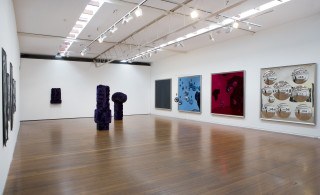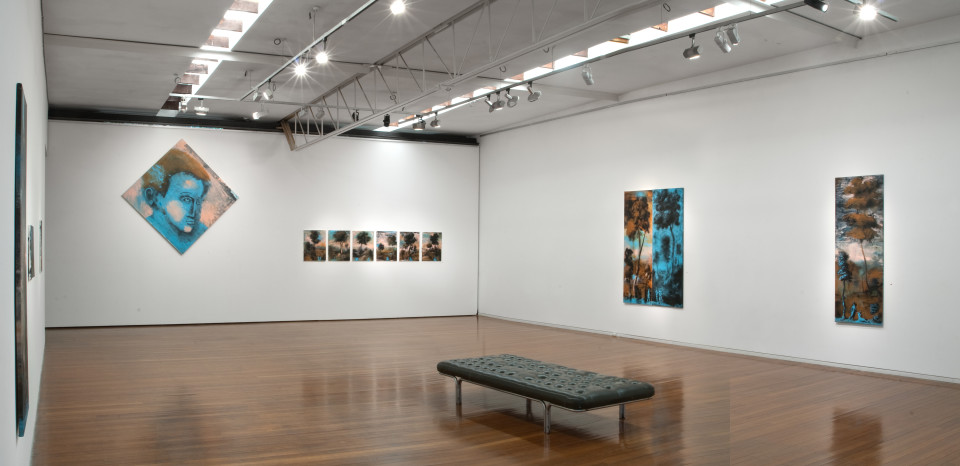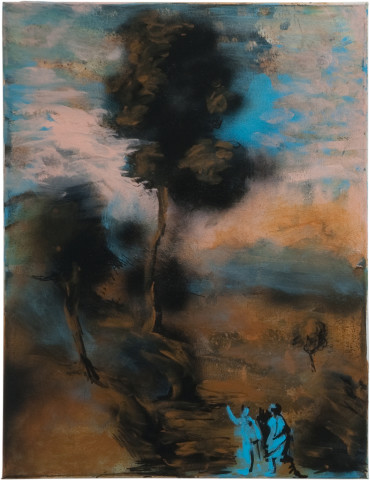At what point does a 'landscape with figure' become a 'portrait in a landscape'? This subtle distinction is one of the many tensions that enliven the paintings in Tony Clark’s latest exhibition at Roslyn Oxley9 Gallery, Shakespeare.
Exhibition Dates: 10 February – 5 March 2011
ARTIST INTERVIEW: TONY CLARK, by Ashley Crawford, Australian Art Collector Onine (09-02-2011)
Shakespeare, 2011
At what point does a 'landscape with figure' become a 'portrait in a landscape'? This subtle distinction is one of the many tensions that enliven the paintings in Tony Clark’s latest exhibition at Roslyn Oxley9 Gallery, Shakespeare. Clark’s atmospheric landscapes are furnished (somewhat arbitrarily) with characters from Shakespeare’s plays, importing a literary ‘purpose’ to his compositions in much the same way as Romantic History painters added ‘staffage’ to their canvases. While the figures are assigned a level of agency (by virtue of their character titles), they also read as purely decorative elements in Clark’s sfumato scenes.
For over 25 years Clark has been interested in banal and generic visual forms, with a particular interest in the saturated genre of landscape painting. In 1985 he began a series of 'Myriorama' paintings based on John Clark's nineteenth-century children's game: 'Myriorama, a Collection of Many Thousand Landscapes' (1824). In the original Myriorama, interchangeable cards depicting sections of picturesque landscapes could be re-arranged to form many millions of differing views. The idyllic blend of classical landscape styles married high cultural tradition with populist leisure time. Tony Clark's first Myriorama paintings were similarly painted on standardized 9 x 12" canvasboards, however he has since expanded the project to include much larger canvases. Although varying sizes, the Myriorama paintings are all proportionally the same and could theoretically be installed in a continuous trajectory. The notion of landscape as unique and significant is re-defined in this project as infinite, generic and speaking to an architectural context.
Until recently, figures never appeared in Tony Clark’s Myrioramas. Now, ubiquitous Shakespearean characters emerge in the foreground, reminiscent of classical ruins in ideal vistas or elaborate Tableaux Vivants. The choice of Shakespeare fits. Like landscape painting, Shakespearean texts are a genre in their own right, heavily engrained in the Western literary tradition. Nevertheless we are drawn into Clark’s idyllic depictions of familiar scenes.
For the last ten years Clark has limited himself to a palette of four colours: blue, pink, brown and black. Add to this permanent marker ink and spray paint and suddenly his landscapes enter Pop Art territory. The Classicism of Clark’s forms is tempered with an abstracted, and often artificial, colour scheme. And yet the seemingly anachronistic colours work. They evoke a fantastical, dream-like realm, which communicates (perhaps inadvertently) an essential element of the history of landscape painting: idealism. Despite Clark’s starting point, we find ourselves falling in love with landscape anew.
—Olivia Sophia
—
Tony Clark has exhibited widely in Australia and Europe since 1982. In 1998 a major retrospective exhibition, ‘Tony Clark – Public and Private Paintings 1982-1998’, was held at the Museum of Modern Art at Heide in Melbourne. Clark has been included in many important group exhibitions, such as ‘Documenta IX’ in 1992 and the 1995 Australian Perspecta. His work is held in prestigious collections including the Art Gallery of New South Wales, Sydney, the Museum of Contemporary Art, Sydney, the National Gallery of Victoria, Melbourne, the Art Gallery of Western Australia, the Queensland Art Gallery u0131 Gallery of Modern Art and The TarraWarra Museum of Art. Tony Clark has been exhibiting with Roslyn Oxley9 Gallery since 1983. ‘Shakespere’ will be his thirteenth solo exhibition with the Gallery.

acrylic and permanent marker ink on canvas
6 parts: 61 x 305 cm (overall); each panel: 61 x 46 cm


61 x 46 cm

acrylic and permanent marker ink on canvas
2 parts: 41 x 62 (overall); each panel: 41 x 31 cm

acrylic and permanent marker ink on canvas
61 x 46 cm

acrylic and permanent marker ink on canvas
183.5 x 69 cm

acrylic and permanent marker ink on canvas
183.5 x 69 cm

acrylic and permanent ink marker on canvas
57 x 57 cm
 Group Show
Group Show
Roslyn Oxley9 Gallery, 2015
 Tony Clark Jesus
Tony Clark Jesus
Roslyn Oxley9 Gallery, 2014
 Tony Clark Buehnenbilder
Tony Clark Buehnenbilder
Roslyn Oxley9 Gallery, 2012
 Group Show, Groups Who
Group Show, Groups Who
Roslyn Oxley9 Gallery, 2011-12
 Tony Clark Shakespeare
Tony Clark Shakespeare
Roslyn Oxley9 Gallery, 2011
Group Show, Wilderness: Balnaves Contemporary Painting
Art Gallery of New South Wales, Sydney, 2010
 Group Show, Lucky Town
Group Show, Lucky Town
Roslyn Oxley9 Gallery, 2008-09
 Tony Clark Prix de Rome
Tony Clark Prix de Rome
Roslyn Oxley9 Gallery, 2008
 Group Show, STOLEN RITUAL
Group Show, STOLEN RITUAL
Roslyn Oxley9 Gallery, 2006-07
 Tony Clark Sections from Clark's Myriorama
Tony Clark Sections from Clark's Myriorama
Roslyn Oxley9 Gallery, 2006
 Group Show, If these walls could talk
Group Show, If these walls could talk
Roslyn Oxley9 Gallery, 2005
 Tony Clark Flowerpieces
Tony Clark Flowerpieces
Roslyn Oxley9 Gallery, 2003
 Group Show, The First 20 Years
Group Show, The First 20 Years
Roslyn Oxley9 Gallery, 2002
 Group Show, All Stars
Group Show, All Stars
Roslyn Oxley9 Gallery, 2000
 Tony Clark Lontano
Tony Clark Lontano
Roslyn Oxley9 Gallery, 2000
 Tony Clark The Strangeness of Panorama
Tony Clark The Strangeness of Panorama
Roslyn Oxley9 Gallery, 1997
 Group Show, Stockroom
Group Show, Stockroom
Roslyn Oxley9 Gallery, 1995
 Tony Clark Fashion, Decor, Interior
Tony Clark Fashion, Decor, Interior
Roslyn Oxley9 Gallery, 1995
 Tony Clark
Tony Clark
Roslyn Oxley9 Gallery, 1995
 Tony Clark Jasperware Paintings
Tony Clark Jasperware Paintings
Roslyn Oxley9 Gallery, 1994
 Tony Clark
Tony Clark
Roslyn Oxley9 Gallery, 1993
 Group Show
Group Show
Roslyn Oxley9 Gallery, 1992
 Group Show, Christmas show
Group Show, Christmas show
Roslyn Oxley9 Gallery, 1991
 Tony Clark Sections from Clark's Myriorama
Tony Clark Sections from Clark's Myriorama
Roslyn Oxley9 Gallery, 1991
 Group Show
Group Show
Roslyn Oxley9 Gallery, 1990
Tony Clark Bronze Reliefs, Chinoiserie Screens
Roslyn Oxley9 Gallery, 1988
 Group Show, 1968-1988 Selected works
Group Show, 1968-1988 Selected works
Roslyn Oxley9 Gallery, 1988
 Tony Clark Villa Sino-Romana
Tony Clark Villa Sino-Romana
Roslyn Oxley9 Gallery, 1987
 Group Show, The Forbidden Object
Group Show, The Forbidden Object
Roslyn Oxley9 Gallery, 1986
 Group Show, Dreams and Nightmares
Group Show, Dreams and Nightmares
Roslyn Oxley9 Gallery, 1984










